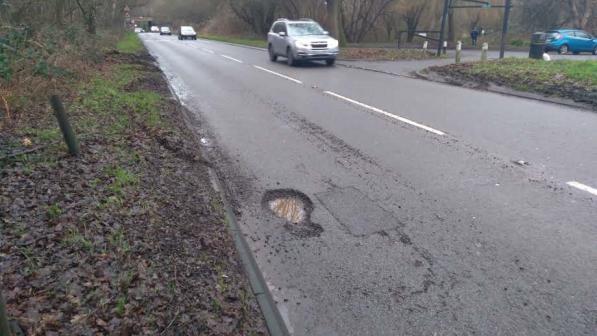Proof is in the pudding for Cycling UK’s miracle pothole filler

For months, the national cycling charity has worked with technical and scientific experts to devise a new cornflour-based substance that can fill holes on our highways at a tiny fraction of the cost of established repairs.
And, astonishingly, the cheapest way to create this miracle filler is by using custard powder, which can be mixed with water to create a non-Newtonian fluid that solidifies to the touch, giving a smooth, flat surface that can be used by cyclists, vehicles and pedestrians.
Cycling UK’s Policy Director, Roger Geffen MBE, said: “The average cost of filling a pothole is £56. Thanks to this incredible breakthrough, we can reduce that cost to little more than THREE PENCE per pothole.
“Bearing in mind there’s an average of one defect for every 110 metres of road in the UK, and there are over 245,000 miles of road, Cycling UK’s initiative has the potential to save the Government and local authorities millions over the coming years – which should allow them to allocate more funding for cycling as well.”
The average cost of filling a pothole is £56. Thanks to this incredible breakthrough, we can reduce that cost to little more than THREE PENCE per pothole.”
Roger Geffen, Cycling UK Policy Director
Professor Joseph King, of the London Asphalt Research Fellowship, said: “Cycling UK appointed us to explore a cheaper alternative to asphalt for filling potholes, and we have spent the past eight months investigating the issue before finally finding a solution in the most unlikely of places.
“We had exhausted all avenues of inquiry when someone suggested trying custard powder – quite seriously, rather than in jest. To our amazement, after weeks of extensive tests, we found it worked.
“Custard is thickened by corn starch, which turns it into a non-Newtonian fluid. Unlike water, if you apply sudden force to a non-Newtonian fluid it will either solidify, as in the case of custard and quicksand, or liquefy, which happens to ketchup and paint. So if you cycle over a pothole filled with custard, the energy of the impact causes the starch to act like a solid.
“We can use a food dye to ensure the repair turns to Tarmac grey – although we are also investigating the possibility of using a fluorescent yellow that can be easily seen by cyclists. We will be contacting the Department for Transport with our findings today (Friday 1 April).”
Cycling UK’s Geffen added: “We obtained a grant to cover the cost of the research from the Foundation Of Operational Logistics and it has proved money well spent.
“We might not have a non-Etonian government, but we do have a non-Newtonian fluid that can save Mr Cameron and his friends a lot of money. We are very grateful to Professor Joe King and his fellow researchers at L.A.R.F.”
While other custard powders are available, our researchers found Bird’s to be the most successful in tests. With a 300g tub costing about £1 and providing 30 or more servings, it means a small pothole can be filled for just a few pence – 0.05% of the current cost using traditional materials.
And, of course, cyclists can report potholes to their local councils by using our popular Fill That Hole app.
A spokesperson for Bird’s said: “The Bird’s brand is best known for its original homemade taste custard powder, invented by Alfred Bird in 1837 – more than 40 years before Cycling UK was founded.
“We are intrigued to hear that another potential and beneficial use for our custard powder may have been found after all this time. We have yet to see any evidence ourselves but look forward to doing so soon. After all, the spoof is in the pudding.”

